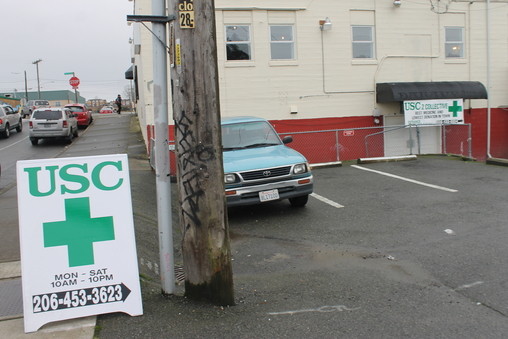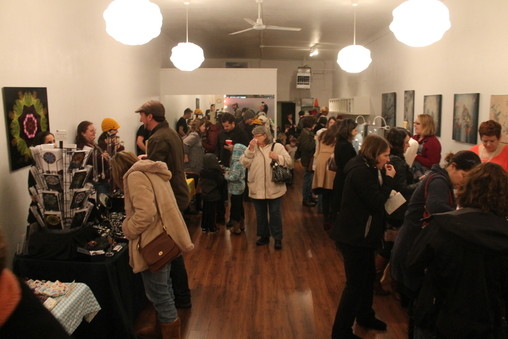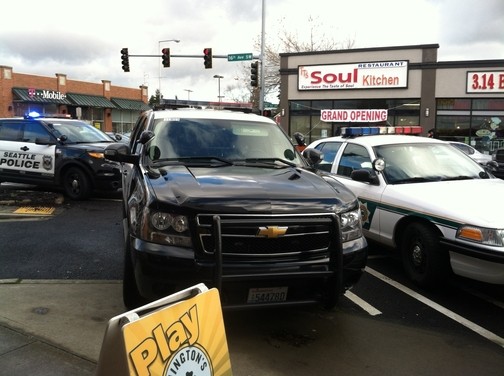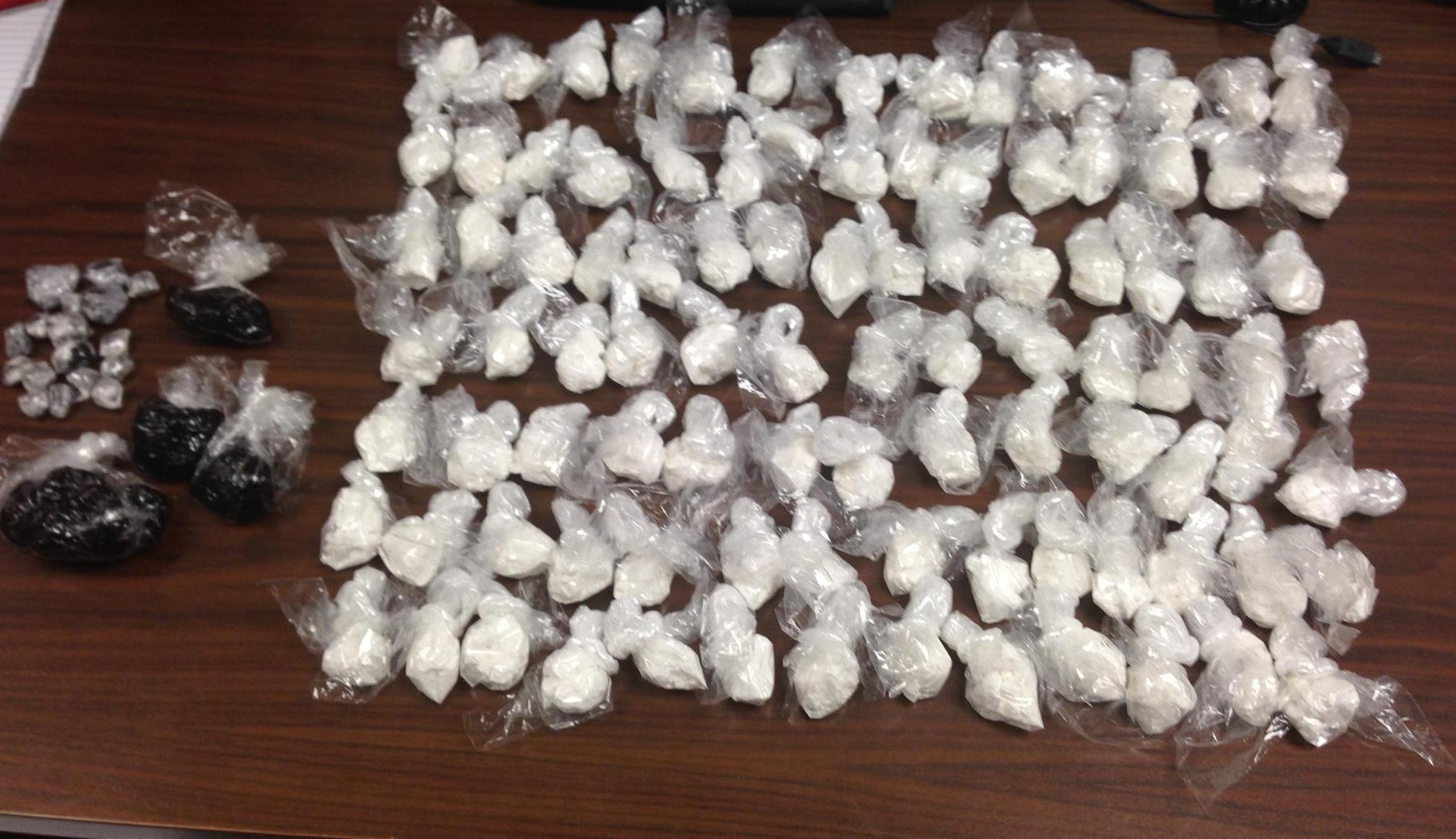The most recent round of bids to take unincorporated areas off King County’s hands have now gone 0-3: In last November’s election, White Center and vicinity said no to Burien and the West Hill area said no to Renton; tonight, King County’s Boundary Review Board said no to Tukwila’s proposed annexation of the Duwamish Triangle – aka North Highline Area Q – on the south side of South Park. More details on our partner site The South Park News.
Another annexation rejected: Tukwila’s Duwamish Triangle bid
January 10th, 2013 at 11:14 pm Posted in Annexation, South Park, White Center news | 4 Comments »
Leadership election for 34th District Democrats tonight
January 9th, 2013 at 10:36 pm Posted in Politics, White Center news | Comments Off on Leadership election for 34th District Democrats tonight

(34th District Democrats’ leadership, photographed tonight by Patrick Sand for WCN/WSB)
Meeting tonight at West Seattle’s Hall at Fauntleroy, this area’s largest political organization, the 34th District Democrats, elected new leadership slate during their annual reorganization meeting. The candidates listed, with bios, on this page of the 34th DDs’ website all ran unopposed and were elected:
Chair – Marcee Stone-Vekich
1st Vice Chair – Ted Barker
2nd Vice Chair – Tamsen Spengler
Treasurer – Karen Chilcutt
Secretary – Marlene Allbright
State Committeeman – Chris Porter
State Committeewoman – Lisa Plymate
King County Committeewoman – Maria Ramirez
King County Committeeman – Michael Arnold
KC Committeewoman Alternate – Layne Batista
KC Committeeman Alternate – Jimmy Haun
Our photo above includes those newly elected leaders as well as committee chairs and other group leaders – including White Center’s Aileen Sison, Diversity Committee chair. The 34th Legislative District encompasses White Center and vicinity as well as part of Burien, West Seattle, and Vashon/Maury Islands. The 34th DDs meet regularly on the second Wednesday of the month, 7 pm, at The Hall at Fauntleroy (9131 California SW in West Seattle).
Meantime, the 34th DDs are co-hosting an Inauguration Day bash, and you’re invited:
2013 Inaugural Party
Hosted by
West Seattle Democratic Women and the 34th District DemocratsMonday January 21, 5-9 PM
at the West Seattle Golf Course
Music By
The West Seattle Big BandTickets: $40 ($75 Couple) Cocktail Attire (must buy tickets online by 1/16/2013)
https://www.completecampaigns.com/public.asp?name=34thDem&page=7Buffet Dancing No-Host Bar
Co-Sponsored By
The West Seattle Democratic Women
and The 34th District Democrats
For more information go to www.34dems.org/2013
Or call (206) 935-4693 or email martintam@gmail.com
Taking down the tree? Boy Scout Troop 375 can help with that
January 5th, 2013 at 12:08 pm Posted in Burien, Environment, White Center news | Comments Off on Taking down the tree? Boy Scout Troop 375 can help with that
Bring your tree and a bag – leave without tree, with hot chocolate and/or compost! From Boy Scout Troop 375 Scoutmaster Mark Ufkes:
Boy Scout Troop 375 will host its annual Christmas Tree Recycle (today and tomorrow), January 5 and 6 from 9 am to 4 pm at SW 160th and 1st SW (the Herr lumber site) We ask for a $5 donation per tree. Funds go to our scout camp and other troop activities so that all our 28 boys can go to summer camp regardless of their family economic situation.
Free hot chocolate will be served. And our polite boys will remove your tree from your car and share a smile.
Free bags of our “Good Karma Christmas Tree Compost” are available for the asking. Bring a bag!
Burien benefit tonight for Joshua Watler’s fight against leukemia
January 5th, 2013 at 10:16 am Posted in Health, White Center news | Comments Off on Burien benefit tonight for Joshua Watler’s fight against leukemia
Tonight at Bison Creek Pizza in Burien, friends and family are gathering to raise money for Joshua Watler, a community organizer who has worked around the region but is now in his biggest fight yet – for his life, battling a second round of leukemia (ALL).
White Center’s Full Tilt, Company, Proletariat Pizza, and 3.14 Bakery are among those who have donated to the silent auction and raffle tonight, 5-10:30 pm at Bison Creek. (Here’s the Facebook event.)
If you haven’t met Joshua – here’s what event organizers write about him:
First diagnosed in 2009, Joshua has not only survived surgery to remove a tumor, intensive chemo, and years of maintenance chemo, but while he was doing all that the first time, he started a unique community union (OUR Washington) for regular people – often the most disenfranchised and ignored people in our society.
He then started a second nonprofit (WA Prosperity Center) to connect the members of his community union and the members of the larger community with available services. He did all this, again, while undergoing cancer treatment. Joshua achieved his first remission last spring. Unfortunately, just 6 months later, the leukemia returned. This time, his only option for survival is a bone marrow transplant. Joshua has been approved and found a match and the dates are set, but now he needs your help; we need to raise $10,000 in just a few weeks to cover his portion of the bone marrow transplant. After the transplant, Joshua will be disabled for several months (up to a year), and he will need further help with funds. Please help us keep Joshua alive, for his sake, for the sake of those of us who love him, and for the sake of the community he serves.
To find out more – go to tonight’s event! And check out these links – Joshua’s Trust Fund and Joshua’s public Facebook page.
DNA match brings arrest in Top Hat home invasion/rape case
January 3rd, 2013 at 2:21 pm Posted in Top Hat, White Center news | Comments Off on DNA match brings arrest in Top Hat home invasion/rape case
There’s been an arrest in the November Top Hat home invasion/rape case, thanks to a DNA match. From the King County Sheriff’s Office:
DNA evidence led detectives to a 17-year-old man who was arrested this morning in connection with a Home Invasion Robbery and Rape that occurred (in the Top Hat area) in November.
Detectives recovered DNA at the scene of the rape/robbery and entered the information into a DNA database (CODA). The DNA from the scene matched that of a known subject.
King County Sheriff’s Detectives and TAC 30 (Swat) served a warrant early this morning at the man’s residence in the 6800 block of S123rd St in the Skyway area. The man was arrested for rape and robbery and booked into the Youth Service Center.
The rape/robbery occurred on November 12th around 8:40 pm in the 10800 block of 6 Ave S. The victims, a man and his girlfriend, were home with their 18 month old child when two armed men entered the apartment and pistol whipped the man and sexually assaulted his girlfriend.
Detectives said the second suspect is still unidentified.
The suspect’s name will be withheld pending charges. The case has been forwarded to the prosecutor for review.
Sheriff’s deputies investigate mystery shooting
January 3rd, 2013 at 10:41 am Posted in White Center news | Comments Off on Sheriff’s deputies investigate mystery shooting
King County Sheriff’s Office says a man was shot in the leg in White Center this morning – but nobody is sure yet how he got shot:
On 1/3/12 around 445 in the morning we responded to a call of a shooting in the area of the 9800 block of 15 ave SW. When we arrived we found a 42 year old Burien man with an apparent shotgun wound to the leg.
A witness said he saw the victim and another man talking and then heard a loud bang. One of the males left the area and the other was on the ground with an injured leg from the shotgun. The injured man was unable to tell deputies what happened. The shotgun was recovered nearby.
Unknown at this time how the man was shot.
White Center scene: Pond gleaming in winter sunshine
January 2nd, 2013 at 4:53 pm Posted in Weather, White Center news | Comments Off on White Center scene: Pond gleaming in winter sunshine

Thanks to Gill for sharing that photo from about noon today, as the White Center Neighborhood Pond gleamed in the winter sunshine. This might be the end of the afternoon sunshine, though – forecast says clouds and rain are headed back this way.
White Center New Year’s Eve: Tonight’s parties
December 31st, 2012 at 2:56 pm Posted in Holidays, White Center news | 1 Comment »
We know of at least two in the downtown White Center vicinity – who else?
*Company Bar – Special dinner menu, plus dancing with DJ at 9 pm, midnight champagne toast too.
*Mac’s Triangle Pub – New Year’s Eve Karaoke, “Puttin’ on the Glitz,” 9 pm-close, no cover, midnight champagne toast and party favors, presented by PCM Musiq Productions.
Blood drive at Holy Family today
December 29th, 2012 at 5:14 am Posted in Holy Family, How to Help, White Center news | Comments Off on Blood drive at Holy Family today
If you can give – consider stopping by 10 am-4 pm (except for the noon-1 pm break time) – this time of year has a higher demand and lower donation rate, so Puget Sound Blood Center is at Holy Family‘s Tice Hall (20th/Roxbury).
King County Sheriff’s Office helicopter damaged – but backup’s in place
December 28th, 2012 at 7:15 pm Posted in King County Sheriff's Office, White Center news | 5 Comments »

Though the King County Sheriff’s Office helicopter Guardian One – used by law-enforcement agencies besides KCSO, including Seattle Police – is in the shop, the department still has one to use if it needs to. So replied KCSO spokesperson Sgt. Cindi West when we followed up on this announcement (which included the photo above):
Earlier today, our Guardian One helicopter was preparing to respond to a burglary in progress and was damaged during the warmup phase. The pilot was preparing the helicopter for lift off. Due to an unknown cause, the helicopter became unstable on a dolly and was damaged. No injuries were reported. The FAA responded to conduct an investigation and has released the helicopter to the Sheriff’s Office for repairs. The Sheriff’s Office will also be conducting an investigation into the cause of the accident and amount (of) damage sustained.
But no, they’re not grounded, Sgt. West reassured WCN: “We do have a backup helicopter and we are still fully functional.”
White Center businesses: New medical-marijuana outlet USC 2 opens
December 27th, 2012 at 10:49 pm Posted in Medical marijuana, White Center news | 5 Comments »

A new medical-marijuana dispensary has just opened in downtown White Center – on the lower level of the White Center building that once housed a short-lived medical-marijuana “lounge.” The lower rear entry of the building on the southwest corner of 16th/98th is the doorway for USC 2. (“USC” also was the name of the dispensary that was briefly open in the southernmost block of Delridge, just a few blocks away from this location, and now – according to one online directory – is in South Seattle.) USC 2 has yet to respond to our note with a few followup questions; with its opening in the building that previously was home to The Wall, The Hang Around, and GAME Lounge, there are now three marijuana businesses within about a block of each other on 16th in downtown WC – Herban Legends, the Northwest Cannabis Market, and this one. Their status has not been affected by the passage of Initiative 502, which requires the state to come up with rules for growers and sellers by next November, at which time it’ll take applications for people interested in entering the cannabis business.
From the WCN Event Calendar: No North Highline UAC meeting this month
December 26th, 2012 at 11:45 pm Posted in North Highline UAC, White Center news | Comments Off on From the WCN Event Calendar: No North Highline UAC meeting this month
The North Highline Unincorporated Area Council usually meets on the first Thursday of the month, but not this month. From president Barbara Dobkin:
The North Highline Unincorporated Area Council will not be holding a meeting in January. Please stay tuned for information regarding the February 7, 2013 meeting. See you all then.
NHUAC is online at northhighlineuac.org.
Southgate Roller Rink featured tonight on ‘Top Chef’
December 26th, 2012 at 4:47 pm Posted in southgate, White Center news | Comments Off on Southgate Roller Rink featured tonight on ‘Top Chef’
Thanks to Chris for the original tip – and it’s confirmed on the Southgate Roller Rink Facebook page: The rink is featured in tonight’s edition of “Top Chef” on Bravo. The Rat City Rollergirls are featured too. The show’s official webpage says it’s on at 10 pm.
Transit reminder: Metro on ‘reduced weekday’ schedule today
December 24th, 2012 at 4:16 am Posted in Metro, Transportation, White Center news | Comments Off on Transit reminder: Metro on ‘reduced weekday’ schedule today
If you’re taking Metro today, remember that it’s on “reduced weekday schedule” – that’s today, Wednesday, Thursday, and Friday, while on Tuesday (Christmas Day) Metro will follow the Sunday schedule.
Followup: New details on Tuesday’s drug-ring raids
December 20th, 2012 at 12:10 pm Posted in Crime, White Center news | Comments Off on Followup: New details on Tuesday’s drug-ring raids

Back on Tuesday, we reported on a drug investigation with search warrants served at locations including one in White Center, and King County Sheriff’s Office said more details would be forthcoming. Today, a news release and photos bring those details:
An 8-month investigation conducted by the King County Sheriff’s Office resulted in the seizure of narcotics, guns, money and the arrest of 8 people for trafficking narcotics.
The investigation started in April when detectives learned that about a narcotics dealer that had the reputation of selling high-quality cocaine and heroin in the Burien area. Detectives learned that the suspect had been sought by investigators before for dealing narcotics but would shut down his operation when he suspected police were closing in.
Detectives spent months conducting surveillance on the suspect’s residence and other locations they learned were connected to the operation. On Wednesday the King County Sheriff’s Office served search warrants on six locations including a residence in the 1600 blk of SW116 St. in Burien and a residence in the 1200 blk of SW107th St. The other locations included a residence and storage unit in Renton, and a house in Federal Way.
8 adults, 7 of them family members were arrested in the raids and 6 children were placed in CPS custody.
In total, items seized were:
1.25 pound of cocaine with a street value of $22,000
6 ounces of heroin with a street value of $2,000
$65,371 in US Currency
5 firearms all of which appeared to be packaged for transport into Mexico
5 vehicles valued at $60,000
White Center Crime Watch: Search warrants served in drug cases
December 18th, 2012 at 4:30 pm Posted in Crime, King County Sheriff's Office, White Center news | 1 Comment »
We received multiple inquiries this morning about what looked like some type of SWAT operation near 12th and 107th – with a loud explosive-type sound at one point. Here’s what we were able to find out from King County Sheriff’s Office spokesperson Sgt. Cindi West: She says detectives served five search warrants this morning, including that one, plus one near the 1600 block of SW 116th in north Burien, and the other three at residences in Federal Way and Renton as well as a storage facility near Renton. Sgt. West adds: “The focus was a narcotics ring involving family members … several people were arrested, some guns and money were recovered, as well as quite a few ounces of cocaine and some heroin.” One of the neighbors we heard from says a deputy told him the explosive sound was a “flash-bang” device often used in such situations to startle occupants and assist officers with carrying out the operation safely. Sgt. West hopes to get more information tomorrow.
Can you help solve a $2 million heist?
December 17th, 2012 at 2:36 am Posted in White Center news | Comments Off on Can you help solve a $2 million heist?
The King County Sheriff’s Office is hoping someone can help solve a $2 million heist. From KCSO spokesperson Sgt. Cindi West:
More than 7,000 Wii game consoles were stolen from a distributing warehouse in SeaTac in the last 24 hours and detectives are asking for the public’s help in locating the van and trailers they were stolen in.
Employees at Seattle Air Cargo in the 19100 blk of Des Moines Memorial Dr said the theft occurred sometime between 9pm Saturday night and noon on Sunday. The suspects used forklifts on the premises to load up two 53’ trailers and a box van with at least 64 pallets of Wii game consoles.
Both Trailers are 53’ in length, white in color and have the name “McKinney” on the side:
The box van is a large International van with “Seattle Air Cargo” written on the doors. (Note: Seattle Air Cargo is NOT written on the side of the box, only the doors):
Trailer #1- California license plate 4HB3365 with a trailer number 533457
Trailer #2- California license plate 4EA5521 with trailer number 531841
Box Van- make “International” Washington license plate B40622K
Detectives believe the suspects drove two tractor trucks to the warehouse and used forklifts inside to load up the trailers and box van with the pallets of Wii games. Detectives estimate the value of property stolen including the vehicles is over $2 million.
If you have information about this crime please call the King County Sheriff’s Office at (206) 296-3311 or 911 if you see any of the vehicles.
White Center Weather Watch: Windy night expected
December 16th, 2012 at 9:35 pm Posted in White Center news | Comments Off on White Center Weather Watch: Windy night expected
As of 10 pm, the National Weather Service’s wind advisory for our area will be in effect, till 4 pm tomorrow – see it here. The worst of the wind is expected to happen further south and much further north, but still be ready for a possibly blustery night. And then, the forecast for Monday night and Tuesday DOES hint at possible snow in the higher hills/ridges of the lowlands. Seattle City Light has updated its Power Lines site to say it’s prepared in case of outages, with extra staff. We’ll update with any more key information as we get it.
Happening now (till 8 pm): Blithe Bazaar at Center Studio
December 15th, 2012 at 6:07 pm Posted in Arts, Holidays, White Center news | Comments Off on Happening now (till 8 pm): Blithe Bazaar at Center Studio

It’s a full house at Center Studio, with arts/crafts vendors from White Center and West Seattle during the studio’s first Blithe Bazaar, continuing till 8 pm. Most of the participating arts/crafts vendors are listed here.

But we didn’t see the listing for proprietor Lonjina Verdugo’s son Adrian:

His duct-tape wallets are just one of many items you’ll find at 9611 16th SW in downtown White Center till 8 pm.
Seattle Police helping KCSO with White Center investigation
December 14th, 2012 at 2:29 pm Posted in Crime, King County Sheriff's Office, White Center news | Comments Off on Seattle Police helping KCSO with White Center investigation

(SPD, KCSO cars near the scene)
Thanks to those who tipped us about Seattle Police out in force on the White Center side of 16th and Roxbury – and beyond. They’re involved right now with a robbery investigation involving the gold-buying store on the southwest corner of the intersection. Though that store is on the county side, the call apparently came first to SPD, according to King County Sheriff’s Office spokesperson Sgt. Cindi West, who says this is all still unfolding, so full details won’t be available till later. A vehicle description went out and SPD wound up involved with stopping that vehicle in Burien, around 139th and Ambaum, where, Sgt. West says, at least two people are in custody. More later.




